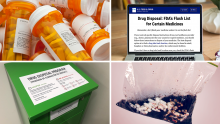The .gov means it’s official.
Federal government websites often end in .gov or .mil. Before sharing sensitive information, make sure you’re on a federal government site.
The site is secure.
The https:// ensures that you are connecting to the official website and that any information you provide is encrypted and transmitted securely.
On Oct. 1, 2024, the FDA began implementing a reorganization impacting many parts of the agency. We are in the process of updating FDA.gov content to reflect these changes.
Español
Is your medicine cabinet full of expired drugs or medications you no longer use? Your medicine is for you. What’s safe for you might be harmful for someone else. The best way to dispose of your expired, unwanted, or unused medicines is through a drug take back program — or you can do it at home.
The U.S. Drug Enforcement Administration (DEA) sponsors National Prescription Drug Take Back Day in communities nationwide. Many communities also have their own drug take back programs. Check with your local law enforcement officials to find a location near you or with the DEA to find a DEA-authorized collector in your community.
You can also check with your pharmacist. Some pharmacies offer on-site medicine drop-off boxes, mail-back programs, and other ways to help you safely dispose your unused medicines.
When a take back option is not easily available, there are two ways to dispose of medicines at home, depending on the drug.
Flushing medicines: Because some medicines could be especially harmful to others, they have specific directions to immediately flush them down the sink or toilet when they are no longer needed, and a take-back option is not readily available.
How will you know? Check the label or the patient information leaflet with your medicine. Or consult the U.S. Food and Drug Administration’s list of medicines recommended for disposal by flushing when a take back option is not readily available. Remember, don’t flush your medicine unless it is on the flush list.
Disposing medicines in household trash: If a take back program is not available, almost all medicines, except those on the FDA flush list (see below), can be thrown into your household trash. These include prescription and over-the-counter (OTC) drugs in pills, liquids, drops, patches, and creams.
Follow these steps:
If you have a question about your medicine, ask your health care provider or pharmacist.
The fentanyl patch is an example of a product that contains a powerful opioid medicine that can be dangerous to people it’s not prescribed for. This adhesive patch delivers a strong pain medicine through the skin.
Even after a patch is used, a lot of the medicine remains. That’s why the drug comes with instructions to flush used or leftover patches.
One environmental concern involves inhalers used by people who have asthma or other breathing problems, such as chronic obstructive pulmonary disease. Read handling instructions on the labeling of inhalers and aerosol products.
These products could be dangerous if punctured or thrown into a fire or incinerator. To properly dispose of these products and follow local regulations and laws, contact your trash and recycling facility.
Some people wonder if it’s okay to flush certain medicines when a take back option is not easily available. There are concerns about the small levels of drugs that may be found in surface water, such as rivers and lakes, and in drinking water supplies.
“The main way drug residues enter water systems is by people taking medicines and then naturally passing them through their bodies,” says Raanan Bloom, Ph.D., an environmental assessment expert at the FDA. “Many drugs are not completely absorbed or metabolized by the body and can enter the environment after passing through wastewater treatment plants.”
The FDA and the U.S. Environmental Protection Agency take the concerns of flushing certain medicines in the environment seriously. Still, there has been no sign of environmental effects caused by flushing recommended drugs. In fact, the FDA published a paper to assess this concern, finding negligible risk of environmental effects caused by flushing recommended drugs.
For more information on what to do when you no longer need your medicines, visit this FDA page.
Subscribe to receive Consumer Updates email notifications.
